
Bucharest is the capital and largest city of Romania, as well as its cultural, industrial, and financial centre. It is located in the southeast of the country, on the banks of the Dâmbovița River, less than 60 km (37.3 mi) north of the Danube River and the Bulgarian border.

Pitești is a city in Romania, located on the river Argeș. The capital and largest city of Argeș County, it is an important commercial and industrial center, as well as the home of two universities. Pitești is situated in the historical region of Muntenia. It lies on the A1 freeway connecting the city directly to the national capital Bucharest, being an important railway junction, with a classification yard in nearby Bălilești. The city houses the Arpechim oil refinery, and is a marketing center for the automotive industry, in particular, Automobile Dacia.
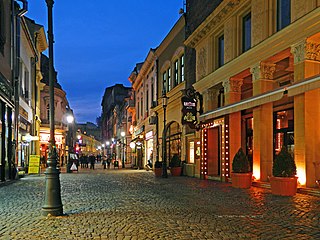
Lipscani is a street and a district of Bucharest, Romania, which from the Middle Ages to the early 19th century was the most important commercial area of the city and Wallachia. It is located near the ruins of the old Princely Court built by Vlad III the Impaler.

Manuc's Inn is the oldest operating hotel building in Bucharest, Romania. It also houses a popular restaurant, several bars, a coffee-house, and several stores and an extensive bar. Its massive, multiply balconied courtyard hosted many performances and fairs and was a popular place for Romanian Television crews to shoot folkloric performances. The hotel and restaurant were refurbished in 2007.
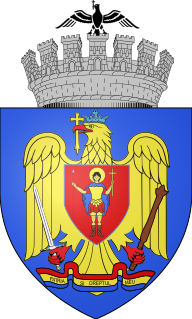
The history of Bucharest covers the time from the early settlements on the locality's territory until its modern existence as a city, capital of Wallachia, and present-day capital of Romania.

Colentina is a neighborhood in Bucharest's Sector 2. It is located on the north-east of the city and is named after the nearby Colentina River.
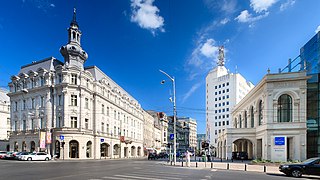
Calea Victoriei is a major avenue in central Bucharest. Situated in Sector 1, and having a length of 2.7 kilometres (1.7 mi), it leads from Splaiul Independenței to the north and then northwest up to Piața Victoriei, where Șoseaua Kiseleff continues north.
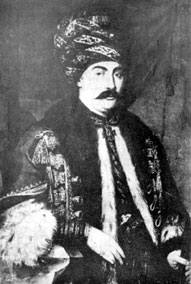
Manuc Bey was an Armenian merchant, diplomat and inn-keeper.
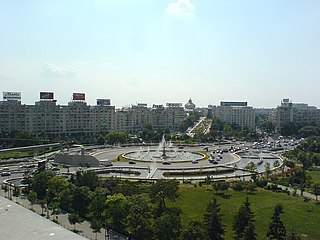
Piața Unirii is one of the largest squares in central Bucharest, Romania, located in the center of the city where Sectors 1, 2, 3, and 4 meet. Part of the Civic Centre, it is bisected by Unirii Boulevard, originally built during the Communist era as the Boulevard of the Victory of Socialism, and renamed after the Romanian Revolution.
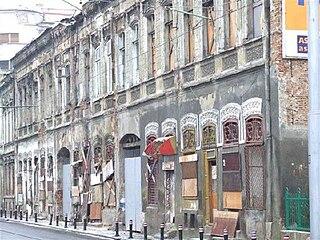
Solacoglu Inn improperly called inn, was actually a factory for producing pasta in Bucharest. It is located along Calea Moşilor, a trading avenue that used to make the connection between Bucharest's Inner Town and the largest marketplace in the town. Its architecture blends traditional outlines with a few Western elements. It was constructed in 1859 for Solacoglu Brothers, merchants from Svishtov, Bulgaria who had settled in Wallachia. In the 1990s the city government evacuated the illegal inhabitants and the bureaucratic process of restoring the building was supposed to begin, but it did not. The building lies nowadays in a bad, ruined state, with its doors and windows blocked off by metal strings bars and plates. During the war of independence from the Ottoman empire 1877. The head of the Bulgarian diaspora lived in the building. The Romanians and Bulgarians were allies in this war of liberation from the Ottomans.

Hanul cu Tei is one of the few still standing old inns in central Bucharest, Romania.
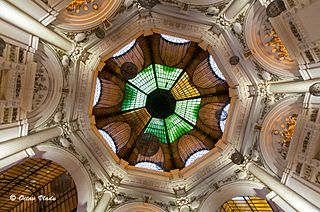
Pasajul Macca-Vilacrosse is a fork-shaped, yellow glass covered arcaded street in central Bucharest, Romania. Câmpineanu Inn once stood in the place nowadays occupied by the passage.

Calea Moșilor is both a historic street and a major road in Bucharest, Romania. It runs from the back of the Cocor Shopping Mall to Obor.

The Great Fire of Bucharest was the largest conflagration ever to occur in Bucharest, Romania, then the capital of Wallachia. It started on March 23, 1847 and destroyed 1850 buildings, a third of the city, including, according to Prince Gheorghe Bibescu, "the most populated and richest part of Bucharest".
The following is a timeline of the history of the city of Bucharest, Romania.

The Șerban Vodă Inn was an inn in Bucharest, Romania, founded by Hospodar Șerban Cantacuzino in the 1680s, it was finally opened for business in 1685. Administered by the Cotroceni Monastery, the inn was, for much of its history, the most important in Bucharest.
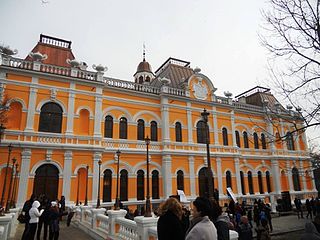
The mansion of Manuc Bey is a modern palace and is located in the city of Hânceşti in the central western part of Moldova. It consists of a larger building complex: Manucs Palace, the Steward's House, the hunting lodge of Countess Çadır, a watch tower and other buildings.

The St. Elijah–Colței Inn Church is a Romanian Orthodox church located at 18 Doamnei Street in the Lipscani quarter of Bucharest, Romania. It is dedicated to the Prophet Elijah.

New St. George Church is a Romanian Orthodox church located in Bucharest, Romania, along the city center's main north–south thoroughfare, where it intersects the Lipscani area. It is dedicated to Saint George. The church is associated with Constantin Brâncoveanu: it was built during his reign and he is buried inside.


















